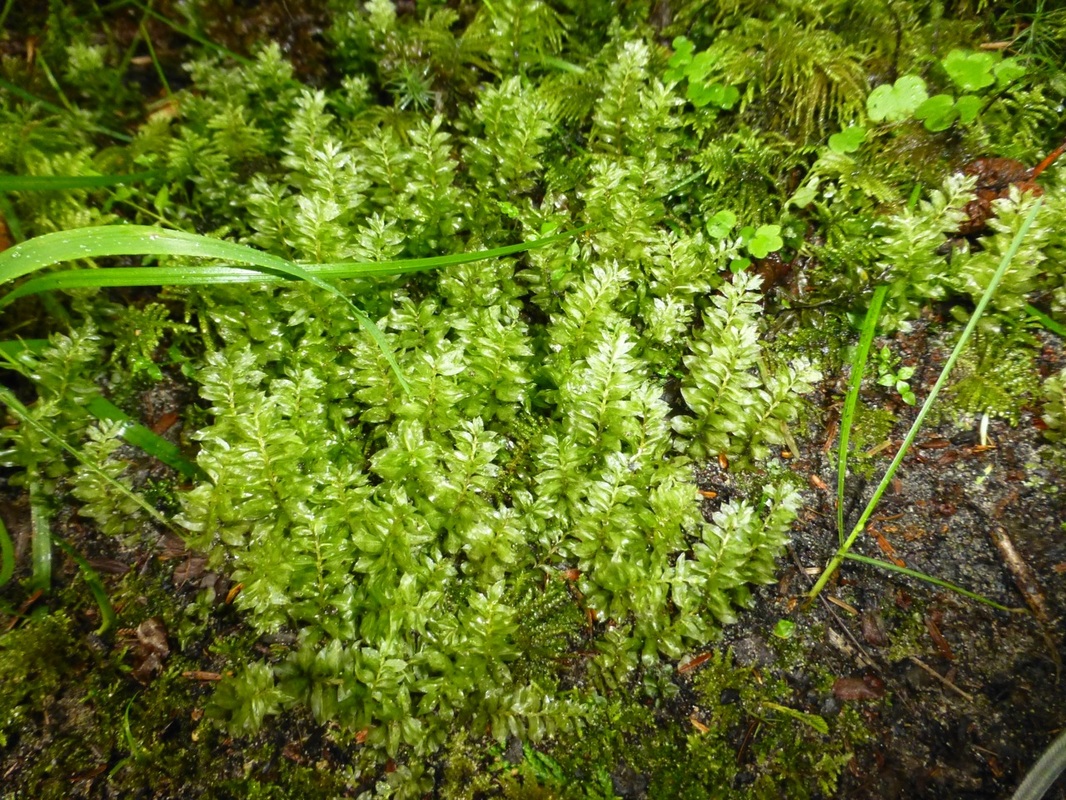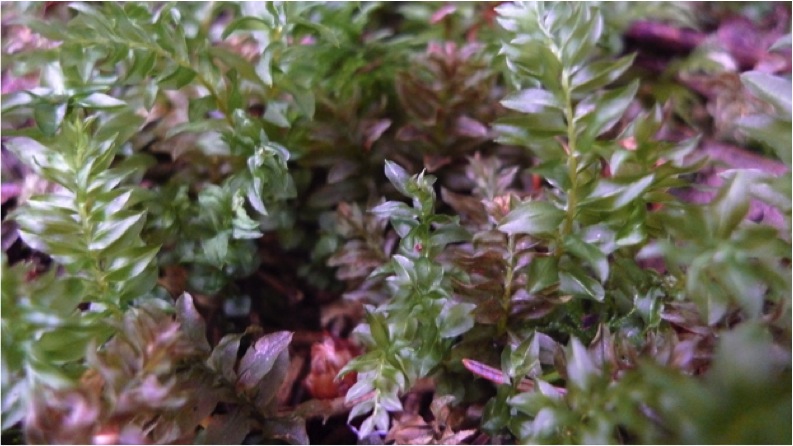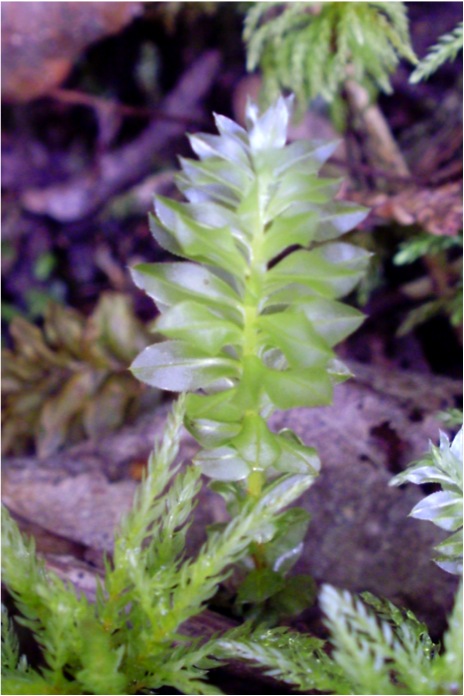Badge moss, coastal leafy moss, plagiomnium moss • Plagiomnium insigne, Mnium insigne
Identification
Badge moss is a large leafy moss with separate male and female fertile plants. It grows 3-8 cm tall, and has 5-7 mm long oval or egg-shaped leaves with pointed ends. The leaves have a border of single sharp teeth composed of elongated cells, and the leave bases extend down the stem. In moist conditions these leaves are shiny and spread out (as in above photos). When the leaves dry up they become dull and shrivelled. The tops of male plants have a rosette of leaves, like male fan moss plants. Sporophytes are common - they grow from the tips of female plants, have long green stalks and cylindrical greenish-yellow hanging capsules, and occur in groupings of 3-6 per plant. Sterile plants have arched stems.
Click here for a more detailed description and some useful illustrations.
Habitat & Range
Badge moss grows in moist, shaded forests, along stream banks, on lawns, and around swampy habitats. It grows on soil rich in decomposing plant matter, on decaying logs, and on tree trunks, and in loose, tall spreading moss mats. It is found up to subalpine elevations, but is most common in coastal areas near sea level.
Similar Species
Magnificent moss is a similar Plagiomnium species found along coastal BC - it is also a large, leafy moss, with leaves bordered by single teeth. It does not have separate male and female plants, does not have extended leaf bases attached to the stem, and has 1-4 sporophytes per female plant. Magnificent moss is generally found south of the Central Coast, and is also smaller than badge moss, the largest of the Plagiomnium species.
Intriguing Info
Badge moss leaves lack a water-conservation adaptation many other mosses use, which is to pull the leaves up against the stem to lessen evaporation. The leaves shrivel up instead. This is because they grow in habitats that are usually adequately moist.
iNaturalist
https://www.inaturalist.org/taxa/122705-Plagiomnium-insigne
Badge moss is a large leafy moss with separate male and female fertile plants. It grows 3-8 cm tall, and has 5-7 mm long oval or egg-shaped leaves with pointed ends. The leaves have a border of single sharp teeth composed of elongated cells, and the leave bases extend down the stem. In moist conditions these leaves are shiny and spread out (as in above photos). When the leaves dry up they become dull and shrivelled. The tops of male plants have a rosette of leaves, like male fan moss plants. Sporophytes are common - they grow from the tips of female plants, have long green stalks and cylindrical greenish-yellow hanging capsules, and occur in groupings of 3-6 per plant. Sterile plants have arched stems.
Click here for a more detailed description and some useful illustrations.
Habitat & Range
Badge moss grows in moist, shaded forests, along stream banks, on lawns, and around swampy habitats. It grows on soil rich in decomposing plant matter, on decaying logs, and on tree trunks, and in loose, tall spreading moss mats. It is found up to subalpine elevations, but is most common in coastal areas near sea level.
Similar Species
Magnificent moss is a similar Plagiomnium species found along coastal BC - it is also a large, leafy moss, with leaves bordered by single teeth. It does not have separate male and female plants, does not have extended leaf bases attached to the stem, and has 1-4 sporophytes per female plant. Magnificent moss is generally found south of the Central Coast, and is also smaller than badge moss, the largest of the Plagiomnium species.
Intriguing Info
Badge moss leaves lack a water-conservation adaptation many other mosses use, which is to pull the leaves up against the stem to lessen evaporation. The leaves shrivel up instead. This is because they grow in habitats that are usually adequately moist.
iNaturalist
https://www.inaturalist.org/taxa/122705-Plagiomnium-insigne
References
Ellis, S. Plagiomnium insigne. Introduction to Bryophytes. Biology 321, Department of Biology, University of British Columbia, Vancouver. Accessed 30/08/2013.
Pojar, J. and MacKinnon, A. (1994). Plants of Coastal British Columbia. Vancouver, BC: Lone Pine Publishing. P. 457.
Schofield, W. Plagiomnium insigne (Mitt.) Kop. In Klinkenberg, Brian. (Ed.). E-Flora BC: Electronic Atlas of the Plants of British Columbia. Lab for Advanced Spatial Analysis, Department of Geography, University of British Columbia, Vancouver. Accessed 30/08/2013.
Authors and editors of page
Kelly Fretwell and Brian Starzomski (2013).
Ellis, S. Plagiomnium insigne. Introduction to Bryophytes. Biology 321, Department of Biology, University of British Columbia, Vancouver. Accessed 30/08/2013.
Pojar, J. and MacKinnon, A. (1994). Plants of Coastal British Columbia. Vancouver, BC: Lone Pine Publishing. P. 457.
Schofield, W. Plagiomnium insigne (Mitt.) Kop. In Klinkenberg, Brian. (Ed.). E-Flora BC: Electronic Atlas of the Plants of British Columbia. Lab for Advanced Spatial Analysis, Department of Geography, University of British Columbia, Vancouver. Accessed 30/08/2013.
Authors and editors of page
Kelly Fretwell and Brian Starzomski (2013).







